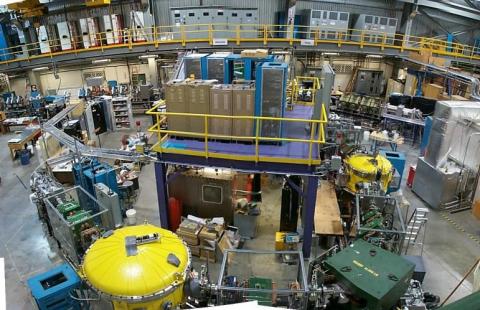
The DRAGON facility continues to push the boundaries of nuclear astrophysics research. DRAGON investigates nuclear reactions involving radioactive isotopes that occur in cosmic explosions, such as novae, supernovae, and X-ray bursts, by bombarding a light gas target with radioactive beams. DRAGON, although not a new facility, continues to push the boundaries at the forefront of nuclear astrophysics. Recently, the facility ran the highest mass radiative-capture experiment ever performed with a radioactive beam, and in so doing, probed the upper mass limit for nucleosynthesis in novae. This will give us a deeper understanding of the formation of heavy elements in the cosmos.
In the experiment, a potassium-38 (K-38) ion beam was collided with a hydrogen gas target. In some cases, the K-38 nucleus captures a proton and emits a gamma ray, becoming calcium-39 (Ca-39) in a so-called radiative-capture reaction. The reaction was conducted at three energies, counting the number of Ca-39 nuclei produced, also known as recoils. Only the highest energy showed a clear recoil signal, indicating that it is relatively strong resonance and the lower energies are relatively weak. A detailed analysis will be applied to the lower energies to search for hidden recoils. Closely examining this process at various energies allows scientists to understand of the formation processes and abundances of various elements, like Ca-40, in the universe.
These results enter into new experimental territory, setting a new world record for the highest mass at which a radiative-capture experiment has ever been performed using a radioactive beam, which is particularly significant since it investigates the highest element masses that can be produced in stellar novae. In a nova, a cataclysmic nuclear explosion is triggered when a hot white dwarf star pulls enough hydrogen away from a nearby stellar companion. These incredibly energetic explosions serve as a ‘nuclear furnace’, cooking up heavy elements to masses around Ca-40. To cook up elements heavier than Ca-40, even more ferocious cosmic environments are required, such as violent supernovae explosions.
This experiment also marks DRAGON's first usage of the ISAC charge state booster. The charge state booster proved to be a fantastic success, providing excellent beam intensity for the duration of the experiment. It's anticipated that future ISAC experiments will also benefit from the high mass radioactive beams that are made possible by the charge state booster.
- Nick Leach, Outreach Assistant
Photo: The DRAGON facility, located in the ISAC building.
